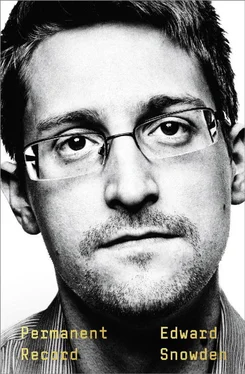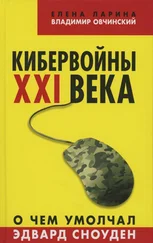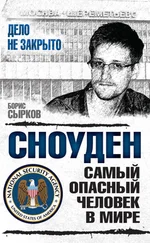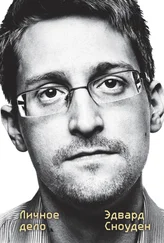I’m a bit ashamed to admit how proud I felt when I first walked through this gloomy array. I was decades younger than the help desk folks and heading past them into a vault to which they didn’t have access and never would. At the time it hadn’t yet occurred to me that the extent of my access meant that the process itself might be broken, that the government had simply given up on meaningfully managing and promoting its talent from within because the new contracting culture meant they no longer had to care. More than any other memory I have of my career, this route of mine past the CIA help desk has come to symbolize for me the generational and cultural change in the IC of which I was a part—the moment when the old-school prepster clique that traditionally staffed the agencies, desperate to keep pace with technologies they could not be bothered to understand, welcomed a new wave of young hackers into the institutional fold and let them develop, have complete access to, and wield complete power over unparalleled technological systems of state control.
In time I came to love the help desk govvies, who were kind and generous to me, and always appreciated my willingness to help even when it wasn’t my job. I, in turn, learned much from them, in bits and pieces, about how the larger organization functioned beyond the Beltway. Some of them had actually worked out in the foreign field themselves once upon a time, like the agents they now assisted over the phone. After a while, they’d come back home to the States, not always with their families intact, and they’d been relegated to the help desk for the remaining years of their careers because they lacked the computer skills required to compete in an agency increasingly focused on expanding its technological capabilities.
I was proud to have won the govvies’ respect, and I was never quite comfortable with how many of my team members condescendingly pitied and even made fun of these bright and committed folks—men and women who for low pay and little glory had given the agency years of their lives, often in inhospitable and even outright dangerous places abroad, at the end of which their ultimate reward was a job picking up phones in a lonely hallway.
* * *
AFTER A FEW weeks familiarizing myself with the systems on the day shift, I moved to nights—6:00 p.m. to 6:00 a.m.—when the help desk was staffed by a discreetly snoozing skeleton crew and the rest of the agency was pretty much dead.
At night, especially between, say, 10:00 p.m. and 4:00 a.m., the CIA was empty and lifeless, a vast and haunted complex with a postapocalyptic feel. All the escalators were stopped and you had to walk them like stairs. Only half of the elevators were working, and the pinging sounds they made, only barely audible during the bustle of daytime, now sounded alarmingly loud. Former CIA directors glared down from their portraits and the bald eagles seemed less like statues than like living predators waiting patiently to swoop in for the kill. American flags billowed like ghosts—spooks in red, white, and blue. The agency had recently committed to a new eco-friendly energy-saving policy and installed motion-sensitive overhead lights: the corridor ahead of you would be swathed in darkness and the lights would switch on when you approached, so that you felt followed, and your footsteps would echo endlessly.
For twelve hours each night, three days on and two days off, I sat in the secure office beyond the help desk, among the twenty desks each bearing two or three computer terminals reserved for the sysadmins who kept the CIA’s global network online. Regardless of how fancy that might sound, the job itself was relatively banal, and can basically be described as waiting for catastrophe to happen. The problems generally weren’t too difficult to solve. The moment something went wrong, I had to log in to try to fix it remotely. If I couldn’t, I had to physically descend into the data center hidden a floor below my own in the New Headquarters Building—or walk the eerie half mile through the connecting tunnel over to the data center in the Old Headquarters Building—and tinker around with the machinery itself.
My partner in this task—the only other person responsible for the nocturnal functioning of the CIA’s entire server architecture—was a guy I’m going to call Frank. He was our team’s great outlier and an exceptional personality in every sense. Besides having a political consciousness (libertarian to the point of stockpiling Krugerrands) and an abiding interest in subjects outside of tech (he read vintage mysteries and thrillers in paperback), he was a fifty-something been-there-done-that ex-navy radio operator who’d managed to graduate from the call center’s ranks thanks to being a contractor.
I have to say, when I first met Frank, I thought: Imagine if my entire life were like the nights I spent at CASL. Because, to put it frankly, Frank did hardly any work at all. At least, that was the impression he liked to project. He enjoyed telling me, and everyone else, that he didn’t really know anything about computing and didn’t understand why they’d put him on such an important team. He used to say that “contracting was the third biggest scam in Washington,” after the income tax and Congress. He claimed he’d advised his boss that he’d be “next to useless” when they suggested moving him to the server team, but they moved him just the same. By his own account, all he’d done at work for the better part of the last decade was sit around and read books, though sometimes he’d also play games of solitaire—with a real deck of cards, not on the computer, of course—and reminisce about former wives (“she was a keeper”) and girlfriends (“she took my car but it was worth it”). Sometimes he’d just pace all night and reload the Drudge Report.
When the phone rang to signal that something was broken, and bouncing a server didn’t fix it, he’d just report it to the day shift. Essentially, his philosophy (if you could call it that) was that the night shift had to end sometime and the day shift had a deeper bench. Apparently, however, the day shift had gotten tired of coming in to work every morning to find Frank’s feet up in front of the digital equivalent of a dumpster fire, and so I’d been hired.
For some reason, the agency had decided that it was preferable to bring me in than to let this old guy go. After a couple of weeks of working together, I was convinced that his continued employment had to be the result of some personal connection or favor. To test this hypothesis I tried to draw Frank out, and asked him which CIA directors or other agency brass he’d been with in the navy. But my question only provoked a tirade about how basically none of the navy vets high up at the agency had been enlisted men—they’d all been officers, which explained so much about the agency’s dismal record. This lecture went on and on, until suddenly a panicked expression came over his face and he jumped up and said, “I gotta change the tape!”
I had no idea what he was talking about. But Frank was already heading to the gray door at the back of our vault, which opened onto a dingy stairwell that gave direct access to the data center itself—the humming, freezing night-black chamber that we sat directly on top of.
Going down into a server vault—especially the CIA’s—can be a disorienting experience. You descend into darkness blinking with green and red LEDs like an evil Christmas, vibrating with the whir of the industrial fans cooling the precious rack-mounted machinery to prevent it from melting down. Being there was always a bit dizzying—even without a manic older guy cursing like the sailor he was as he dashed down the server hall.
Frank stopped by a shabby corner that housed a makeshift cubicle of reclaimed equipment, marked as belonging to the Directorate of Operations. Taking up almost the entirety of the sad, rickety desk was an old computer. On closer inspection, it was something from the early ’90s, or even the late ’80s, older than anything I remembered from my father’s Coast Guard lab—a computer so ancient that it shouldn’t even have been called a computer. It was more properly a machine , running a miniature tape format that I didn’t recognize but was pretty sure would have been welcomed by the Smithsonian.
Читать дальше












